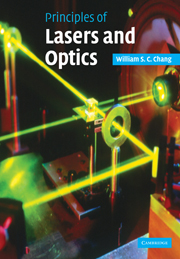Book contents
- Frontmatter
- Contents
- Preface
- 1 Scalar wave equations and diffraction of laser radiation
- 2 Gaussian modes in optical laser cavities and Gaussian beam optics
- 3 Guided wave modes and their propagation
- 4 Guided wave interactions and photonic devices
- 5 Macroscopic properties of materials from stimulated emission and absorption
- 6 Solid state and gas laser amplifier and oscillator
- 7 Semiconductor lasers
- Index
- References
4 - Guided wave interactions and photonic devices
Published online by Cambridge University Press: 06 July 2010
- Frontmatter
- Contents
- Preface
- 1 Scalar wave equations and diffraction of laser radiation
- 2 Gaussian modes in optical laser cavities and Gaussian beam optics
- 3 Guided wave modes and their propagation
- 4 Guided wave interactions and photonic devices
- 5 Macroscopic properties of materials from stimulated emission and absorption
- 6 Solid state and gas laser amplifier and oscillator
- 7 Semiconductor lasers
- Index
- References
Summary
In order to understand optical fiber communication components and systems, we need to know how laser radiation functions in photonic devices. The operation of many important photonic devices is based on the interactions of several guided waves. We have already discussed the electromagnetic analysis of the individual modes in planar and channel waveguides in Chapter 3. From that discussion, it is clear that solving Maxwell's equations simultaneously for several modes or waveguides is too difficult. There are only approximate and numerical solutions. In this chapter, we will first learn special electromagnetic techniques for analyzing the interactions of guided waves. Based on these techniques, practical devices such as the grating filter, the directional coupler, the acousto-optical deflector, the Mach– Zehnder modulator and the multimode interference coupler will be discussed. The analysis techniques are very similar to those techniques used in microwaves, except we do not have metallic boundaries in optical waveguides, only open dielectric structures.
The special mathematical techniques to be presented here include the perturbation method, the coupled mode analysis and the super-mode analysis (see also ref.). In guided wave devices, the amplitude of radiation modes is usually negligible at any reasonable distance from the discontinuity. Thus, in these analyses, the radiation modes such as the substrate and air modes in waveguides and the cladding modes in fibers are neglected. They are important only when radiation loss must be accounted for in the vicinity of any dielectric discontinuity.
- Type
- Chapter
- Information
- Principles of Lasers and Optics , pp. 114 - 148Publisher: Cambridge University PressPrint publication year: 2005

